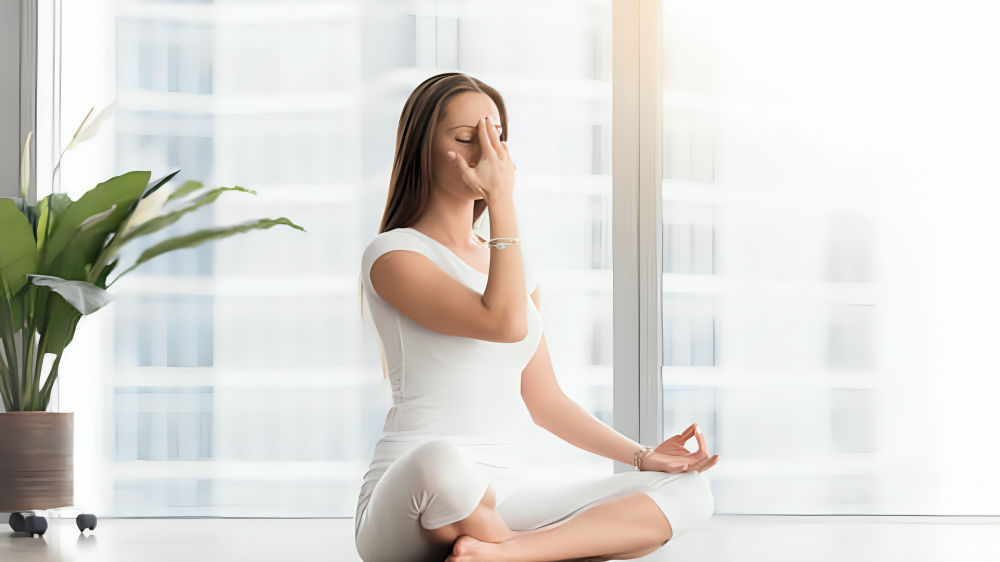
What is Nadi Shodhana Pranayama?
Nadi Shodhana Pranayama refers to one of the breathing techniques in yoga that alternates nostrils. By definition, “Nadi” refers to energy channels innate within the body, while “Shodhana” means purifying. It would, therefore, literally mean purification of the body’s energy channels. This, then, would help in balancing the flow of Prana by alternating the nostrils.
How to Perform Nadi Shodhana Pranayama
Assume a Comfortable Seated Posture
Easy Pose – Sit comfortably, as on floor with legs crossed or on chair with your feet touching the floor. Keep your spine straight and shoulders relaxed.
Place Left Hand Place your left hand on your left knee in a relaxed position. The right hand is used for breathing
Setup Your Right Hand
Vishnu Mudra: So bring the right hand towards the nose. Fold the index and middle fingers down towards the palm. This mudra will enable one in closing in the nostrils by using the thumb and ring finger.
The Breathing Process Begins
Close Your Right Nostril: Take your right thumb to close your right nostril.
Inhale softly and slowly through the left nostril, filling the lungs completely.
At the top of the in-breath, close the left nostril with a hand position that is analogous to placing the left thumb and open the right nostril.
Slowly and fully exhale through the right nostril.
At the top of the out-breath, gently close the right nostril, opening the left side of the body, and inhale directly again through the left nostril.
Switch and Close Your Right Nostril: At the peak of your inhalation, with your thumb, close your right nostril.
Exhale Through Your Left Nostril: Let go of your ring finger on your left nostril and excrete your breath completely and slowly.
Repeat the Cycle
Continuous Practice: Practise this for approximately 5-10 minutes. Pay attention to smooth, steady breathing, and your breath will become quiet and deep.
End the Practice
Return to Normal Breathing: Once one is done with the practice, return to normal breathing and sit quietly for some time, observing the effects of the practice on the body and mind.
Benefits of Nadi Shodhana Pranayama
Reduces Stress and Anxiety
It helps to quiet the mind by focusing on the breath and practicing the technique over and over again. Slow breathing and in control slows down the heart rate, relaxing the nervous system in return.
Improved Concentration and Focus
This is because Nadi Shodhana Pranayama balances the left and right hemispheres of the brain, leading to greater mental clarity. It is very effective for concentration and focus; hence, it can be done before studying or working.
Balances Energy Channels
This breathing technique is purposed to balance the energy channels of your body. Once your energy channels are in a balanced state, you will see more energy, stability, and harmony throughout your day.
Supports Respiratory Health
This asana, if practised on a regular basis, will help in enhancing lung functioning and respiratory efficiency. The method of slow and deep breathing expands oxygen supply to the blood, cleaning the respiratory system.
Better Sleep
People suffering from sleep disorders can try the Nadi Shodhana Pranayama before going to bed. It relaxes your body and enables you to enjoy sound sleep.
Enhance Self-Awareness
Since the attention of your mind is vested in your breath and the movement of energy in the body, greater awareness of what goes on inside you is achieved. It acts as a grounding element; staying in the present improves self-awareness, regulates emotions.
It’s here Ujjayi Pranayama How to Do It and What Are the Benefits
FAQs
1. Who can practice Nadi Shodhana Pranayama?
Almost anybody can practice it, but if somebody suffers from certain medical conditions or feels discomforts in breathing, then it is always advisable to consult a doctor before commencing any new practice.
2. How often can I practice Nadi Shodhana Pranayama?
You can do it every day, but start with 5-10 minutes and increase your time when you are acclimatized.
3. What is the best time to practice Nadi Shodhana Pranayama?
The best times to practice are early in the morning or in the evening when the mind is calm. You can, however do it anytime if you want to get relaxed or focused.

